You Won’t Believe It: These 11 Car Features Already Existed Last Century
A look back at 11 car innovations that were way ahead of their time

For decades, automakers have been competing to grab consumers’ attention with clever engineering and cutting-edge features. Many of the things we take for granted in cars today actually first appeared decades ago — and were considered high-tech marvels of their time. Here are 11 innovations from the past century that paved the way for the technology we see in modern vehicles.
11. Adaptive Headlights (1960s)
The concept of headlights that turn with the steering wheel isn’t new at all. Back in the mid-20th century, Tucker cars featured a system where the headlights followed the direction of the front wheels, improving visibility on dark, winding roads. Citroën later took this idea mainstream with its legendary DS model, which also used turning headlights to illuminate curves.
10. Rear Passenger Climate Control (1960s)
Cadillac was among the first automakers to introduce separate climate controls for backseat passengers. In select 1960s models, those riding in the rear could set their own preferred temperature without asking the driver to adjust the system up front — a real luxury for its time.
9. Voice-Controlled Radio (1990s)
Before Siri or Alexa, Oldsmobile rolled out a voice-operated audio system called GuideStar in the 1990s. Drivers could control their radios using voice commands, minimizing distractions and making it easier — and safer — to change stations or tracks while driving.
8. Night Vision System (2000s)
Around 2000, the Cadillac DeVille became one of the first production cars to feature a night vision system. Using infrared sensors, it captured heat signatures from people and objects outside the range of the headlights and displayed them on the dashboard screen — helping drivers spot hazards earlier in the dark.
7. Rain-Sensing Wipers (1990s)
Mercedes-Benz pioneered the use of rain sensors that automatically activate windshield wipers when water hits the glass. The system would adjust the wiper speed based on the intensity of the rainfall, improving both visibility and convenience during bad weather.
6. Adaptive Cruise Control (1990s)
Mercedes-Benz also led the way with its Distronic system — one of the first adaptive cruise controls to reach the mass market. It used radar to monitor the distance from the vehicle ahead and automatically adjusted speed to maintain a safe gap. This innovation laid the foundation for today’s advanced driver-assistance systems, including lane-keeping and collision avoidance.

5. Head-Up Display (1980s)
Borrowed from fighter jet technology, head-up displays (HUDs) first appeared in General Motors vehicles in the 1980s. The system projected key information — such as speed, fuel level, and warnings — onto the windshield, allowing drivers to keep their eyes on the road instead of glancing down at the instrument cluster.
4. Seat Memory Function (1980s)
Cadillac’s Seville introduced the world to seat position memory, allowing multiple drivers to save and recall their personalized seat settings. One touch of a button, and the seat would automatically move into your preferred position — a small touch that added a big dose of comfort and convenience.
3. Keyless Entry and Push-Button Start (1990s)
Mercedes-Benz changed the game again in the late 1990s with its SmartKey system — one of the first keyless entry and push-start setups. Drivers could unlock the car simply by touching the door handle and start the engine with the push of a button, no key-turning required.
2. Lane-Keeping Assist (2000s)
In the early 2000s, Infiniti brought lane-departure warning systems to market. These sensors detected when a vehicle began to drift out of its lane and alerted the driver through visual cues or steering wheel vibration. That simple warning evolved into the fully active lane-keeping systems we see today.
1. Parking Sensors (1990s)
One of the most popular driver-assist features today — the parking sensor — actually dates back to 1990s Toyota models. The original Park Assist system emitted beeps or displayed visual alerts as the car approached an obstacle. The idea caught on fast, and now nearly every automaker includes it in their lineup.
You may also be interested in the news:

What Are Those Mysterious Buttons on Your Car Stereo For? Many Drivers Don’t Even Use Them
Most people drive, listen to the radio, and have no idea what some buttons and functions actually do.

Why you shouldn't press these buttons in your car: some could be dangerous
These controls are easy to hit by accident—or out of inexperience, especially for new drivers.

Is Your Car's Start-Stop Feature Helping or Hurting: Am I the Only One It Annoys?
Most modern vehicles come with auto start-stop systems that shut off the engine at stops, but drivers remain divided.

Why a CVT Can Be Better Than a Traditional Automatic: Three Reasons to Rethink Continuously Variable Transmissions
Many drivers still shy away from CVTs out of habit. They’re often seen as delicate, high-maintenance gearboxes that demand constant attention.

Beyond Mileage: Hidden Diagnostic Uses for Your Car's Trip Odometer Button
Why every driver should know about this “hidden” button in their car.